NEET Previous Year Questions (2014-2024): Mechanical Properties of Fluids | Physics Class 11 PDF Download
2023
Q1: The venturi-meter works on [2023]
A: Huygen’s principle
B: Bernoulli’s principle
C: The principle of parallel axes
D: The principle of perpendicular axes
Ans: B
Solution: Venturi-meter works on the Bernoulli’s principle.
Q2: A spherical ball is dropped in a long column of a highly viscous liquid. The curve in the graph shown, which represents the speed of the ball (v) as a function of time (t) is [2022]
A: B
B: C
C: D
D: A
Ans: A
Solution: Initial speed of ball is zero and it finally attains terminal speed
2022
Q1: If a soap bubble expands, the pressure inside the bubble [2022]
A: Increases
B: Remains the same
C: Is equal to the atmospheric pressure
D: Decreases
Ans: D
Solution:
Excess pressure inside the bubble =
P = P0 + 4T/R
as ‘R’ increases ‘P’ decreases
2021
Q1: The velocity of a small ball of mass M and density d, when dropped in a container filled with glycerine becomes constant after some time. If the density of glycerine is d/2, then the viscous force acting on the ball will be: [2021]
A: 3/2Mg
B: 2Mg
C: Mg/2
D: Mg
Ans: C
Solution:
Mass = M
Density of ball = d
Density of glycerine = d/2
2020
Q1: A barometer is constructed using a liquid (density = 760 kg/m3 ). What would be the height of the liquid column, when a mercury barometer reads 76 cm? (Density of mercury = 13600 kg/m3 ) [2020]
A: 1.36 m
B: 13.6 m
C: 136 m
D: 0.76 m
Ans: B
Density of liquid, ρl = 760 kg /m3
Density of mercury, ρm = 13600 kg /m3
Height of liquid column in mercury barometer,
hm = 76 cm = 0.76 m
If height of liquid in liquid column be hl , then

Q2: A liquid does not wet the solid surface if angle of contact is [2020]
A: equal to 45°
B: equal to 60°
C: greater than 90°
D zero
Ans: C
A liquid does not wet the solid surface, if the angle of contact is obtuse i.e., θ > 90º.
2019
Q1: A soap bubble, having radius of 1 mm, is blown from a detergent solution having a surface tension of 2.5 × 10-2 N/m. The pressure inside the bubble equals at a point Z0 below the free surface of water in a container. Taking g = 10 m/s2, density of water = 103 kg/m3, the value of Z0 is [2019]
A: 100 cm
B: 10 cm
C: 1 cm
D: 0.5 cm
Ans: C
Solution:
Excess pressure = 4T/R, Gauge pressure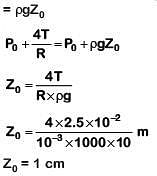
Q2: A small hole with area area of cross-section 2 mm2 is present near the bottom of a fully filled open tank of height 2 m. Taking g = 10 m/s2, the rate of flow of water through the open hole would be nearly [2019]
A: 12.6 × 10–6 m3/s
B: 8.9 × 10–6 m3/s
C: 2.23 × 10–6 m3/s
D: 6.4 × 10–6 m3/s
Ans: A
Solution: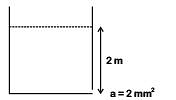
Rate of liquid flow

2018
Q1: A small sphere of radius 'r' falls from rest in a viscous liquid. As a result, heat is produced due to viscous force. The rate of production of heat when the sphere attains its terminal velocity, is proportional to:- [2018]
A: r3
B: r2
C: r5
D: r4
Ans: C
Solution:
2017
Q1: A U tube with both ends open to the atmosphere, is partially filled with water. Oil, which is immiscible with water, is poured into one side until it stands at a distance of 10 mm above the water level on the other side. Meanwhile the water rises by 65 mm from its original level (see diagram). The density of the oil is:- [2017]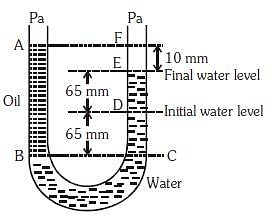
A: 425 kg m–3
B: 800 kg m–3
C: 928 kg m–3
D: 650 kg m–3
Ans: C
Solution:
2016
Q1: Two non-mixing liquids of densities ρ and nρ (n > 1) are put in container. The height of each liquid is h. A solid cylinder of length L and density d is put in this container. The cylinder floats with its axis vertical and length pL (p < 1) in the denser liquid. The density d is equal to [2016]
A: {1 + (n - 1)p}ρ
B: {1 + (n + 1)p}ρ
C: {2+(n + 1)p}ρ
D: {2 + (n - 1)p}ρ
Ans: A
Solution: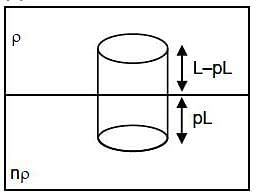
wt of body = upthrust by the two liquids
If A = Area of section then
2015
Q1: The approximate depth of an ocean is 2700 m. The compressibility of water is 45.4 x 10-11 Pa-1 and density of water is 103 kg/m3. What fractional compression of water will be obtained at the bottom of the ocean? [2015]
A: 1.4 x 10-2
B: 0.8 x 10-2
C: 1.0 x 10-2
D: 1.2 x 10-2
Ans: D
Solution:
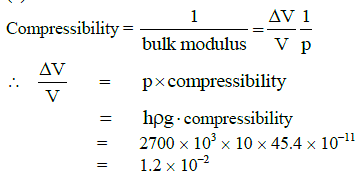
Q2: A wind with speed 40 m/s blows parallel to the roof of a house. The area of the roof is 250 m2. Assuming that the pressure inside the house is atmospheric pressure, the force exerted by the wind on the roof and the direction of the force will be:
(Pair = 1.2 kg/m3) [2015]
A: 2.4 x 105 N, downwards
B: 4.8 x 105 N, downwards
C: 4.8 x 105 N, upwards
D: 2.4 x 105 N, upwards
Ans: D
Solution:


2014
Q1: A certain number of spherical drops of a liquid of radius ‘r’ coalesce to form a single drop of radius ‘R’ and volume ‘V’. If ‘T’ is the surface tension of the liquid, then: [2014]
A: 
B: energy is neither released nor absorbed
C: 
D: 
Ans: A
Solution:
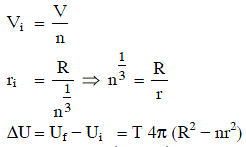
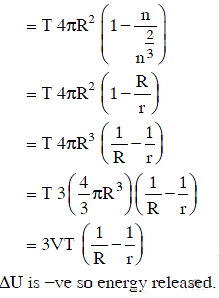
|
97 videos|378 docs|103 tests
|
FAQs on NEET Previous Year Questions (2014-2024): Mechanical Properties of Fluids - Physics Class 11
| 1. What are the different types of mechanical properties of fluids? |  |
| 2. How does viscosity affect the flow of fluids? |  |
| 3. What is the significance of surface tension in fluid mechanics? |  |
| 4. How does compressibility affect the behavior of fluids under pressure? |  |
| 5. What is the bulk modulus of a fluid and how does it relate to its compressibility? |  |

|
Explore Courses for NEET exam
|

|


















